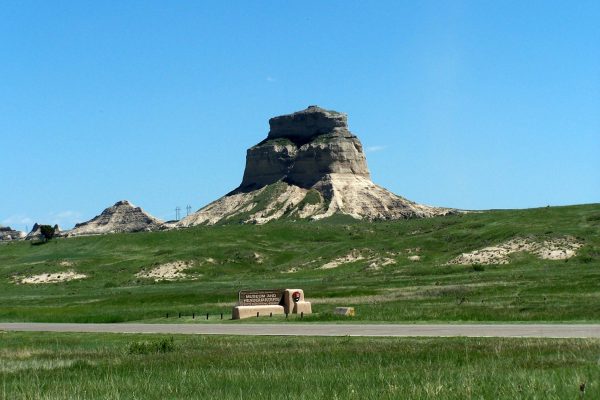
Following the Overland Trails
This summer, the PLHC was working to wrap up a project for Scotts Bluff National Monument. Researcher and recent graduate, Poppie Gullett, has shared a bit about the project and her experience completing archival research during a summer road trip to Scotts Bluff National Monument, Agate Fossil Beds National Monument, and Legacy of the Plains Museum.
Scotts Bluff National Monument
800-foot high Scott’s Bluff is immediately noticeable as a unique natural and cultural landmark. The distinctive formation was a crucial way marker for the Mormon and Oregon Trails as well as the Pony Express. The site received its status as a National Monument for its association with nineteenth-century westward migration. As you approach the dusty pink promontory and feel the sun beating down on you, you can almost imagine the wagon trains and riders that navigated the pass between the bluffs on their way west. The staff at Scott’s Bluff National Monument understand the relationship between their site’s natural beauty and its human history. In 2013, the monument reached out to the Public Lands History Center to help reconceptualize its exhibits. These revitalized exhibits will tell some new stories about Scotts Bluff.
How to Make History
The PLHC team worked for four years writing a ten chapter report on the Monument’s past. My goal in traveling to Scott’s Bluff was to use historic photos, paintings, and documents to develop a StoryMap and a visitor-friendly booklet for the monument. I explored the archives of three museums—Legacy of the Plains Museum just down the road from the Monument, Scott’s Bluff National Monument, and Agate Fossil Beds National Monument.
At each site I found totally different but fascinating primary sources. Agate Fossil Beds yielded some of pioneer artist and photographer William Henry Jackson’s paintings and photos of him exploring the Nile River in Egypt. Visiting Scott’s Bluff allowed me to speak with the monument’s staff and understand their goals. I was also able to look through historic photos salvaged from the flooded basement archives. And at Legacy of the Plains, I spent the morning learning about Nebraska farm “soddies” (sod houses) with their very helpful volunteers. In such a whirlwind trip, I was struck by both the uniqueness of the landscape and the region’s history. There are dozens of tales yet to be told about the Scott’s Bluff area, and I am excited to be involved in that telling.
Story by Poppie Gullett
Support great projects like this one by making a gift to the Public Lands History Center.